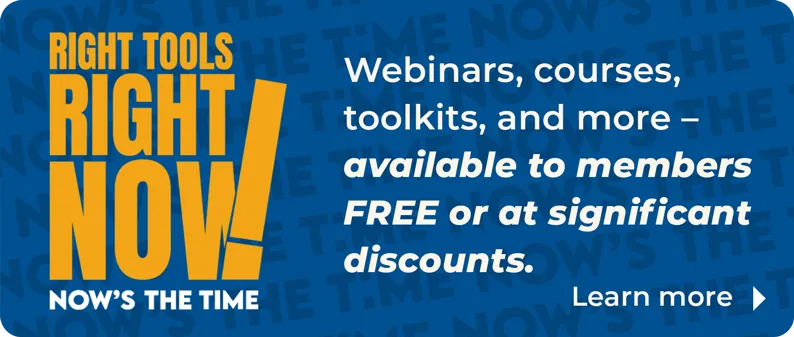
Getting members to pay their dues is obviously necessary, but it can be a stressful process. The fact that billing often coincides with ethics and Core Standards deadlines adds to the stress.
So, how can you make communicating with members about their dues easier and more effective?
We spoke with experts in the field—at small, medium and large associations—for practical advice that works.
Tip No. 1: Email and Then Email Again
No matter the size of your association, email is the most common way to remind members about paying dues.
Nancy M. Ray, who has been the CEO of Capital Region Board of REALTORS® in Concord, N.H., for 13 years, is the sole executive staff member and handles all the dues billing herself using the NAR REALTORS® Electronic Commerce Network.
A key to getting her 350 members to respond is reminders.
“Dues billing statements are emailed to members mid- September, and reminders are sent out mid-October, mid-November and mid-December,” Ray explains. “The final dues reminder is emailed to brokers in mid-January, letting them know the unpaid members in their offices—and the final day to pay dues is Feb. 1.”
The last day to avoid late fees is Dec. 31. After that, members must pay their dues and a $150 late fee; Ray says that the late fee is an incentive to get members to renew by the end of the year. If they miss the Feb. 1 deadline, their memberships become inactive.
If you head a midsized association, as does Ashley Sugar, CEO of Middle Tennessee Association of REALTORS® in Murfreesboro, you might farm out part of the work.
“In 2025, we will be outsourcing some bookkeeping and using RAMCO to run our dues billing,” Sugar says. “We do send follow-up emails and include reminders in the newsletter. We also encourage brokers to seek lists of unpaid agents.”
Because many members prefer to pay dues in person, the association provides an additional grace day in case of bad weather or other delays. But after that, Sugar says, “We try to stick to a $25 late fee once the deadline passes, and then it bumps up to $100 after two weeks. After that, the account will incur a new application fee.”
Dionna Hall, RCE, CEO of Broward, Palm Beaches & St. Lucie REALTORS® and Beaches MLS in Florida, says her association handles dues billing in-house using dedicated staff, even though it is a large association.
“Dues billing can be challenging for an association of any size; however, over the years, we have fine-tuned what works and what doesn’t based on member feedback,” Hall says. “Emails are just one of several touch points we use when following up and retargeting members. We use open receipts and stats to determine when a member has opened our dues billing communications. If they have not taken action, additional follow-up methods include text messages, MLS dashboard notifications and robocalls.”
The association also sends out different dues billing emails to brokers and agents. One begins with “Dear Valued Member” and the other with “Dear Valued Broker.” Then comes a short summary of the basic info the recipient needs to know, followed immediately by a call-to-action button, where members can click and pay. Below the button are links to pages on the association’s website that provide helpful billing information.
“The more frequently we follow up with our members, the more quickly we see results,” Hall says.
Some associations include verbiage that reminds members that REALTOR® dues are not refundable. Some also send a link within the email, directing members to a breakdown of their dues on the association website. Others provide the breakdown, including what part of the dues goes to the National Association of REALTORS®, the state association and then the local association, in the initial email.
Although some messages are short and sweet, others give more information. Choosing how to structure your email can depend on what has worked (or not worked) for you in the past, as well as member feedback.
Some associations also use incentives to encourage early payment of dues. Hall says her association holds a contest, and everyone who pays in full before the due date receives a $50 education credit and an automatic entry to win free local, state and national dues (one winner); free local dues (10 winners); gift cards to American Express (25 winners) or Starbucks (100 winners); or a Supra Lockbox (50 winners).
The more frequently we follow up with our members, the quicker we see results.”
–Dionna Hall, Broward, Palm Beaches & St. Lucie REALTORS® and Beaches MLS
Tip No. 2: Use Grace Periods and Deadlines to Your Advantage
Hall says that while there are usually 45 days from the launch of a dues invoice to the due date, her staff will continue to reach out to unpaid members through a variety of avenues, such as email, text message and the association’s broker concierge program.
“We will also work with members individually when needed to provide payment plans that allow them to stagger the obligation over time, which helps alleviate hardships,” Hall says. “We try to be as accommodating as possible and never lose sight of the fact that real estate is a commission-based business for the vast majority of our members.”
Because dues billing often coincides with ethics and Core Standards deadlines, most associations suggest that preplanning, time management and communication are all key. “We try as much as we can to prep, prep, prep to allow time for the craziness of dues, but it’s hard regardless of how much preparing you do,” Sugar says.
That is, unless your dues billing periods and ethics and Core Standard deadlines are not at the same time, which can also be the case.
“We send out the dues invoices during the summer, which typically avoids any overlap with other deadlines,” says Lisa Forca, director of membership services at Long Island Board of REALTORS® in West Babylon, N.Y. Invoices go out the last week of August, with a due date of Sept. 30. “Following the initial invoice, we send reminder emails 10 days prior to the due date to alert the members who have not remitted payment that the deadline is approaching. In addition, we also message about the dues invoice in our weekly LIBOR news emails to ensure members are well informed.”
LIBOR provides a two-week grace period, and it sends out broker statements to inform brokers of any unpaid members along with upcoming suspension dates.
Forca says that one significant mistake brokers can make is terminating their association membership because of an inability to pay the dues on time. Members mistakenly believe they can reinstate their membership later in the year and receive a prorated bill.
“This is not the case. If a member is terminated and reinstated within the same membership year, their dues are not prorated. Proration only applies in the calendar year the member joins,” she explains. (Note: Individual state and local associations may determine whether to prorate their dues. National dues may not be prorated.)
When members feel a genuine sense of belonging, it becomes significantly more challenging for them to consider leaving the association.”
–Lisa Forca, Long Island Board of REALTORS®









